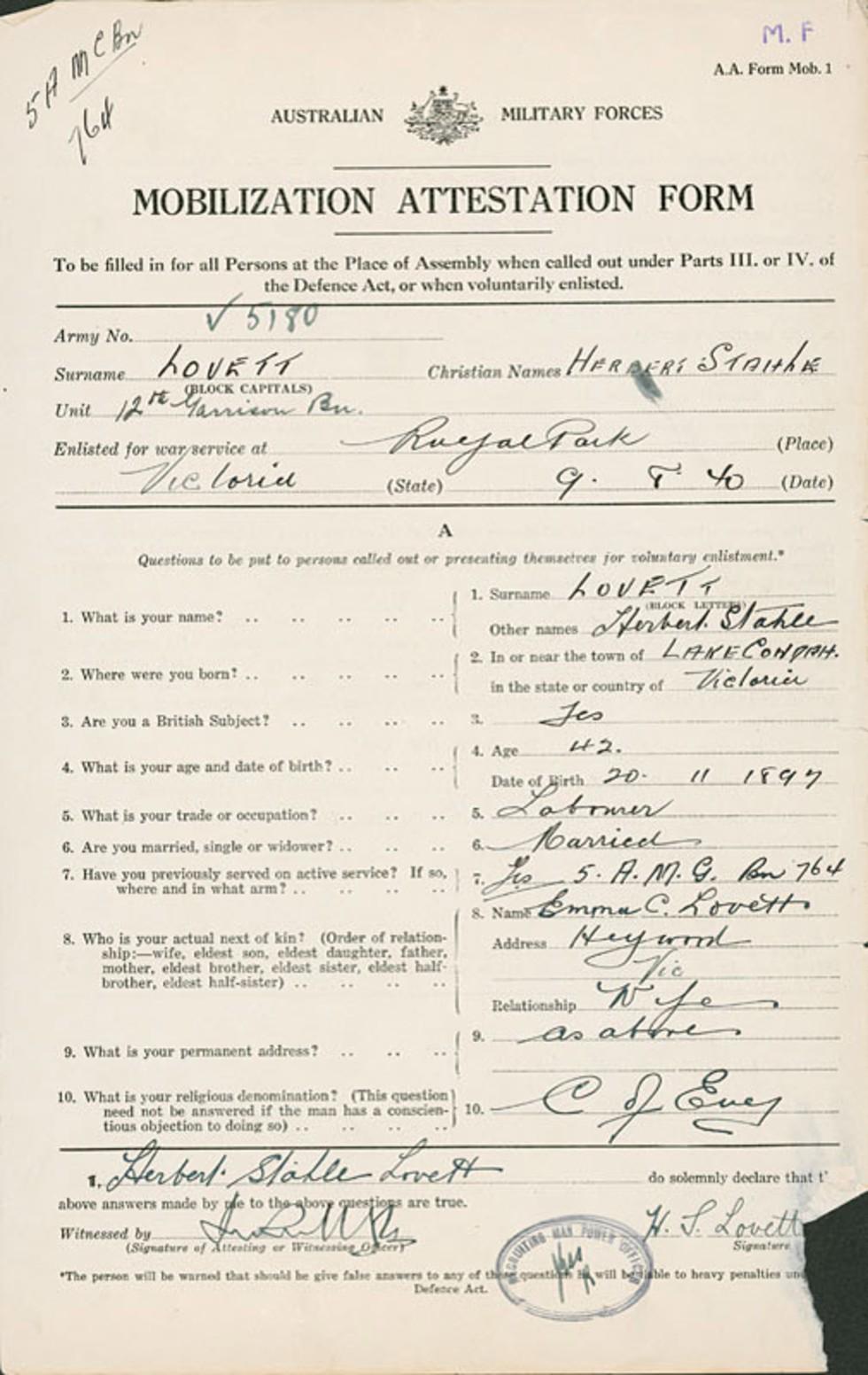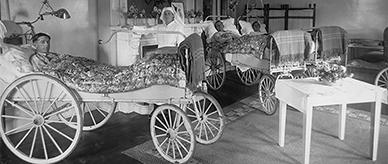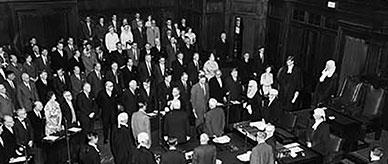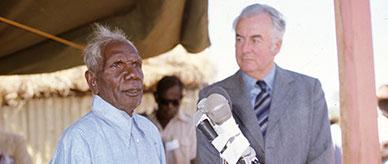


Transcript
[Handwritten, top left corner] 5 A M G Bn [underlined]
764
[Stamped in blue ink, top right corner] M.F.
A.A. Form Mob. 1
[Header, includes text and the Australian Coat of Arms, centred at top of page reads:] AUSTRALIAN MILITARY FORCES[.]
[Heading:] MOBILIZATION ATTESTATION FORM
To be filled in for all Persons at the Place of Assembly when called out under Parts III. or IV. of the Defence Act, or when voluntarily enlisted.
[Dividing line.]
[This form is typed. All responses are handwritten.]
Army No.[:] V5180.
Surname (BLOCK CAPITALS) [:] LOVETT.
Christian Names[:]HERBERT STAHLE.
Unit[:] 12th Garrison Bn.
Enlisted for war service at[:] Royal Park (Place)
Victoria (State)
9.8.40 (Date)
[Dividing line.]
[Section heading:] A
[italicised] Questions to be put to persons called out or presenting themselves for voluntary enlistment. [Asterisk.]
[Asterisk refers to footnote at bottom of page, which reads 'The person will be warned that should he give false answers to any of these question he will be liable to heavy penalties under the Defence Act.']
[The following information is presented in two columns, with the question on the left and the response on the right. All responses are handwritten.]
1. What is your name?
1. Surname (BLOCK LETTERS)[:] LOVETT
Other names[:] Herbert Stahle
2. Where were you born?
2. In or near the town of[:] LAKE CONDAH.
In the state or country of[:] VICTORIA
3. Are you a British Subject?
3. Yes
4. What is your age and date of birth?
4. Age[:] 42
Date of Birth[:] 20.11.1897
5. What is your trade or occupation?
5. Labourer
6. Are you married, single or widower?
6. Married
7. Have you previously served on active service? If so, where and in what arm?
7. Yes. 5.A.M.G. Bn 764
8. Who is your actual next of kin? (Order of relationship:- wife, eldest son, eldest daughter, father, mother, eldest brother, eldest sister, eldest half-brother, eldest half-sister)
8. Name[:] Emma C. Lovett
Address[:] Heywood
Vic
Relationship[:] Wife
9. What is your permanent address?
9. As above
10. What is your religious denomination? (This question need not be answered if the man has a conscientious objection to doing so)
10. C of Eng [Church of England.]
[Dividing line.]
I, Herbert Stahle Lovett [name handwritten] do solemnly declare that the above answers made by me to the above questions are true.a
Witnessed by [illegible handwritten signature.]
(Signature of Attesting or Witnessing Officer)
[Handwritten signature:] H.S. Lovett
(Signature)
[Stamped in black ink 'RECRUITING MAN POWER OFFICER' with handwritten note 'Yass R' written inside stamp.]
[Footnote beginning with asterisk:] The person will be warned that should he give false answers to any of these questions he will be liable to heavy penalties under the Defence Act.
About this record
This is a Mobilization Attestation Form (enlistment form) filled out by Herbert Stahle Lovett, a Gunditjmara man from Lake Condah in Victoria, when he joined the Australian Military Forces during World War II. It includes details such as Lovett’s age, date of birth, occupation, marital status, next of kin, religious denomination and previous military service. The document reveals that Lovett had served with the 5th Machine Gun Battalion in the First World War.
Educational value
- The image shows the enlistment form of Herbert Stahle Lovett who, with three of his brothers—Frederick, Leonard and Edward—served in both world wars. This has given the family a unique record of military service in the Australian armed forces, and possibly in the military history of the British Empire. An older brother, Alfred, also fought in World War I while his younger brother, Samuel, enlisted during World War II.
- Herbert Lovett (Service Number V5180), a Gunditjmara man from Lake Condah Aboriginal mission in the Western District of Victoria, first enlisted in 1917 at the age of 20 and served on the Western Front in France with the 5th Machine Gun Battalion. Lovett did not join up until 1917 because, prior to this date, Aboriginal and Torres Strait Islander men were barred from enlisting. As casualties mounted and enlistments fell, the army decided to accept Aboriginal and Torres Strait Islander men who had one parent of European origin.
- Lovett was 42 years old when he commenced service in World War II on 9 August 1940. His age meant that he did not see active service but was assigned to garrison and catering units. Older recruits usually filled essential but non-combative roles, which then released younger men for active duty. Lovett’s war service record indicates he worked as a cook in the Catering Corps, which provided meals for troops. Lovett was discharged in October 1945.
- In World War I some 400 Aboriginal and Torres Strait Islander men enlisted, and between 3000 and 6000 served in World War II. These recruits may have hoped that by serving their country they would be granted greater rights. While Aboriginal and Torres Strait Islander servicemen were generally treated as equals by non-Indigenous servicemen and received equal pay, on their return from war they found that discrimination in areas such as education, employment and civil liberties remained.
- After serving in both the world wars, Lovett was refused a land grant under the soldier settlement scheme. Following World War I, the Lake Condah Mission—on the traditional land of the Gunditjmara people—was divided into farming blocks for returned servicemen. Some 11,000 veterans were granted land in Victoria, but none were given to Aboriginal soldiers. Only one Indigenous veteran is known to have been granted a soldier settlement block.
- War service records such as Lovett's Attestation Form are vital to historians in piecing together military history. In this instance they reveal both the unique war service of the Lovett family and a little-known social history. For example, when Lovett enlisted in 1917, the recruitment officer noted that his parents 'are not pure-blooded blacks' and he has 'white people on both parents' sides'—which confirms that the army had relaxed their restrictions on Aboriginal and Torres Strait Islander recruits by that date. The statement also shows how the army consciously used the fact that Lovett was not 'full blood' as justification for his recruitment.
Acknowledgments
Learning resource text © Education Services Australia Limited and the National Archives of Australia 2010.
Related themes
Need help with your research?
Learn how to interpret primary sources, use our collection and more.




